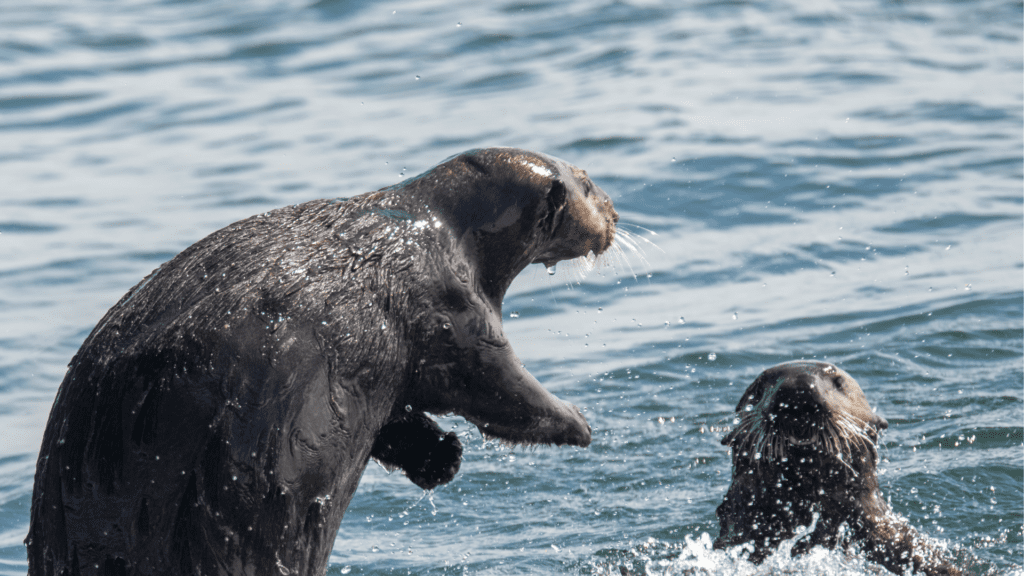Otter Population Management In Wyoming: Reaching A Turning Point

Table of Contents
Current Status of Otter Populations in Wyoming
Understanding the current status of Wyoming's otter population is the first step towards effective management. This involves examining historical trends, geographic distribution, and the various threats they face.
Historical Trends
Otter populations in Wyoming, like many other North American river otter populations, experienced significant decline during the 19th and early 20th centuries. Factors contributing to this decline included:
- Habitat Loss: Extensive alteration of riparian habitats due to dam construction, irrigation projects, and deforestation.
- Pollution: Water contamination from mining activities, agricultural runoff, and industrial discharge.
- Over-Trapping: Historically, otters were heavily trapped for their fur, drastically reducing their numbers.
However, thanks to conservation efforts including successful reintroduction programs and habitat restoration, otter populations have shown signs of recovery in recent decades. While precise population estimates vary, data from the Wyoming Game and Fish Department suggests a gradual increase since the mid-20th century, although precise numbers remain elusive due to the challenges of tracking this elusive species.
Geographic Distribution
Currently, otters in Wyoming are primarily found along major river systems and in lakes with suitable habitat. High-density populations are observed in:
- The Snake River Basin: Otters thrive in this extensive watershed, utilizing diverse habitats along its length.
- The Green River Basin: Similar to the Snake River, the Green River provides crucial habitat, especially in less-disturbed stretches.
- Yellowstone National Park: The park's pristine waterways support a healthy otter population, serving as an important refuge.
Conversely, areas with fragmented habitats, degraded water quality, or limited access to prey experience lower otter densities. Protected areas, like national parks and wildlife refuges, are essential for preserving existing otter populations and facilitating expansion into suitable areas.
Threats to Otter Populations
Despite recovery efforts, several ongoing threats continue to challenge otter populations in Wyoming:
- Habitat Fragmentation: Roads, dams, and other human infrastructure fragment otter habitat, isolating populations and limiting gene flow.
- Water Pollution: Agricultural runoff containing pesticides and fertilizers contaminates waterways, impacting water quality and prey availability.
- Climate Change: Altered precipitation patterns, increased frequency of extreme weather events, and changes in water temperature directly impact otter habitat and prey species.
- Human-Wildlife Conflict: Road mortality is a significant concern, as otters often traverse roads while moving between habitat patches.
Current Management Strategies
Wyoming employs various strategies to manage its otter populations, although these strategies are currently being reevaluated to determine their effectiveness in light of emerging threats.
Monitoring Techniques
Tracking otter populations is challenging due to their elusive nature. The Wyoming Game and Fish Department utilizes a combination of methods:
- Scat Surveys: Identifying and analyzing otter scat (droppings) to estimate population size and distribution.
- Camera Trapping: Using motion-activated cameras to document otter presence and activity.
- Aerial Surveys: Conducting surveys from aircraft to assess habitat use and potential population density.
- Genetic Analysis: Using genetic markers to assess population structure, connectivity, and gene flow between different populations.
Habitat Protection and Restoration
Several conservation efforts aim to enhance and protect otter habitats:
- Riparian Zone Restoration: Planting native vegetation along riverbanks to stabilize shorelines, improve water quality, and provide cover for otters.
- Land Acquisition: Purchasing or securing easements on key riparian properties to protect crucial otter habitat from development.
- Watershed Management: Implementing best management practices for agriculture and forestry to reduce pollution and habitat degradation.
Public Education and Outreach
Educating the public is vital for fostering support for otter conservation. Efforts include:
- Educational Programs: Developing and delivering educational materials and programs to schools, community groups, and the general public.
- Community Outreach Initiatives: Engaging local communities in otter conservation efforts through citizen science projects and volunteer opportunities.
- Collaboration with Stakeholders: Working with landowners, anglers, and other stakeholders to develop and implement effective conservation strategies.
The Need for a New Approach to Otter Population Management
Current management strategies require refinement to address emerging challenges and ensure the long-term health of Wyoming's otter populations.
Adaptive Management
An adaptive management approach is crucial, emphasizing flexibility and data-driven decision making. This involves:
- Continuous Monitoring: Regularly monitoring otter populations and their habitats to track changes and evaluate the effectiveness of management actions.
- Adjusting Strategies: Modifying management strategies based on new information and emerging threats.
- Scenario Planning: Developing and evaluating different management scenarios to anticipate future challenges and adapt accordingly.
Collaboration and Stakeholder Engagement
Successful otter population management necessitates broad collaboration:
- Collaborative Conservation Planning: Developing management plans through collaborative processes involving all relevant stakeholders.
- Participatory Management Approaches: Involving local communities and stakeholders in decision-making processes to enhance buy-in and support.
- Building Partnerships: Fostering strong partnerships between government agencies, non-profit organizations, and private landowners.
Addressing Emerging Threats
Proactive strategies are essential to mitigate emerging threats:
- Water Quality Monitoring Programs: Implementing robust water quality monitoring programs to identify and address pollution sources.
- Degraded Riparian Habitat Restoration: Prioritizing restoration efforts in degraded riparian areas to improve habitat quality.
- Climate Change Mitigation Policies: Advocating for and implementing policies to mitigate the effects of climate change on otter habitats.
Conclusion
Effective otter population management in Wyoming is crucial for maintaining the biodiversity and ecological integrity of the state's aquatic ecosystems. The current approach needs further refinement, incorporating adaptive management strategies, collaborative partnerships, and a proactive response to emerging threats such as climate change and pollution. By prioritizing proactive conservation efforts and engaging all stakeholders, Wyoming can ensure a thriving future for its otter populations. Learn more about how you can contribute to otter population management in Wyoming and participate in ongoing conservation initiatives. Contact your local Wyoming Game and Fish Department office to find out how you can get involved.

Featured Posts
-
 Geen Stijl Vs Abn Amro Debat Over Betaalbaarheid Nederlandse Huizenmarkt
May 22, 2025
Geen Stijl Vs Abn Amro Debat Over Betaalbaarheid Nederlandse Huizenmarkt
May 22, 2025 -
 Solve Wordle April 26 2025 Puzzle 1407 Hints And Answer
May 22, 2025
Solve Wordle April 26 2025 Puzzle 1407 Hints And Answer
May 22, 2025 -
 Major Crash Closes Route 15 On Ramp Motorists Advised To Seek Alternate Routes
May 22, 2025
Major Crash Closes Route 15 On Ramp Motorists Advised To Seek Alternate Routes
May 22, 2025 -
 Jail Term For Mother Over Tweet After Southport Stabbing Incident
May 22, 2025
Jail Term For Mother Over Tweet After Southport Stabbing Incident
May 22, 2025 -
 Ford And Nissans Battery Plant Partnership An Exclusive Look At The Ev Market Shift
May 22, 2025
Ford And Nissans Battery Plant Partnership An Exclusive Look At The Ev Market Shift
May 22, 2025
